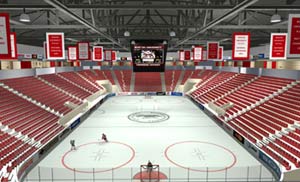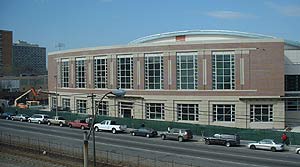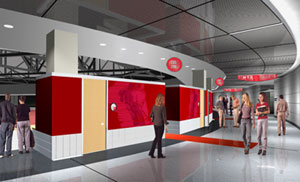When the Harry Agganis Arena opens its door for college hockey — most likely in January 2005 — you might not be able to say that the arena is second to none among college hockey venues.
However, as Tuesday’s tour for the media revealed, you may very well be able to say that it’s second only to Engelstad Arena at the University of North Dakota. Agganis Arena may not have 100,000 square feet of imported granite and seats made of leather and cherry wood, but it’s loaded with amenities and features that the average college hockey fan will love.

The new facility will feature:
• 6,200 seats for ice hockey
• 1,000 premium seats allowing purchasers preferred access to other events, including concerts, figure skating events, and family shows
• retractable seating on the north end of the ice for easy setup of a concert stage
• a 5,600-foot Club Room
• 1,400 parking spaces onsite or within easy walking distance
• six visiting locker/dressing rooms, allowing for tournament play
• a 17×21-foot, four-sided center-hung scoreboard with 8×13.5-foot video displays
These are just a few of the amenities and features. Suffice to say that everything about the facility will be state-of-the-art and fan-friendly.
Boston University Assistant Vice President Peter Smokowski described how many university personnel — including hockey coach Jack Parker — visited numerous university and pro facilities in their quest to create the best possible arena.
“We learned many lessons from this, as the building managers were quite forthcoming about their experiences,” Smokowski said. “Some facilities were built a little too large. We wanted ours to be smaller to be intimate and, frankly, to manage costs.”
Smokowski said that the arena–part of the $225-million Student Village that also includes a recreation center and several dormitories–was influenced by many other veunues. Citing The Boston Garden and Mariucci Arena at the University of Minnesota, Smokowski said, “We loved the intimacy of the seating. The fans are right on top of the action.” He also acknowledged liking Engelstad but that such a facility was beyond their budget. BU liked the “footprint” of Lowell’s Tsongas Arena and also found attractive features at Denver’s Magness Arena and UNH’s Whittemore Center. In the end, though, the intimacy and vertical seating of the Garden was a key facet of the Agganis design.
“Not a seat in the house will be more than 60 feet from the ice surface,” Smokowski said.

Understandably, Jack Parker is extremely excited about the arena’s impact on recruiting — especially with an enormous new conditioning center, a theater-style media viewing area (“We might show Miracle,” quipped Parker), and a gorgeous locker room.
“I think the impact on recruiting has been fabulous,” Parker said. “We might have one of the best classes we’ve ever had coming in here next year. There’s no question that seeing the building go up and knowing that they’d be playing in it next year was a big help for us.”
Parker tried to put the new facility into a long-term perspective.
“This is my 31st year,” Parker said. “When I first took over, I had one of the best rinks in college hockey to recruit for. Over the thirty-odd years, we’ve wound up with a “less-than” facility than everybody else’s. Not that Walter Brown isn’t a good facility, but everybody else has upgraded their facilities and their programs. It’s been difficult that way recruiting-wise.
“Although we have great crowds and a great following here, I think the sizzle of a new weight room, a new dressing room, the new video room — it’s going to be an easier sell for Boston University hockey.”
The Terrier coaching legend was integrally involved in the design of the new facility.
“I wanted the fans to be on top of the players,” Parker said. “The only way that you do that without a balcony is to make sure that the grade of the seats is really steep. The Garden and the Bradley Center in Milwaukee have two of the steepest grades. We tried to go as high as we could grade-wise and still be up to code.”

“I just had about every say you could have in terms of where the benches and dressing rooms were going to be, what the radius of the corners was going to be — I had a lot of say in what the size of the building was going to be. They were talking about making a 9,000-seat arena. I wanted to make sure that we have a full house, that there will be a demand for tickets, and that there will be enthusiasm in the building.”
Comparison shopping significantly aided the effort.
“We went out to Denver University and Colorado College, and I think that they both got it half-right,” Parker said. “If you look at the Denver University rink, it has real attractive curb appeal, to use the real estate term. When you drive up to the place, it looks great. The bowl itself is not symmetrical, so it’s a little off but it’s still nicely finished. But the guts of the building — the dressing rooms, the weight rooms, the equipment rooms, the training room — they were nowhere near up to snuff, I don’t think.
“When you went to Colorado College just an hour away, they built the rink at about the same time. They’re building on the outside is just cement; it didn’t have the appeal that Denver did. But when you got to the guts of the building, they did a great job in that area. So we’re trying to make sure we get the best of both worlds. The real benchmark in my mind is the University of North Dakota, so we’d like to be in the ballpark with them.”
It looks like that the Agganis Arena might just be in that ballpark. There is still some uncertainty about when the arena will be finished, but Parker loves the idea of doing just as the Bruins did when the FleetCenter was completed: Playing a doubleheader against one opponent, with the first game at Walter Brown Arena and the second at Agganis Arena. At best, that could happen with UNH in November. More realistically, that could occur in January 2005 with the University of Minnesota doing the honors as opponent.
Nothing is set in stone just yet. But it should be quite a show-stopper when it occurs; and bear in mind this is just one piece of a Student Village puzzle that is already wowing student and university evaluators. The dorm next to Agganis and the enormous student recreation facility next to it has received many rave reviews.
“They asked one student, a junior in the College of Communication, about how he liked living in the new dorm,” Parker said. “He said, ‘It’s kind of depressing.’ When asked why, he said, ‘I’m a junior in college and I realized this is probably the nicest place I’m ever going to live.'”


